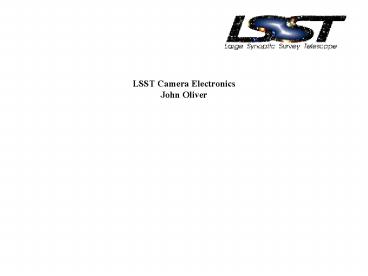LSST Camera Electronics John Oliver PowerPoint PPT Presentation
1 / 18
Title: LSST Camera Electronics John Oliver
1
LSST Camera ElectronicsJohn Oliver
2
Camera Electronics Working Group
- John Oliver (Camera Electronics Project Manager)
- Nathan Felt, Sarah Harder
- - Harvard University
- Paul OConnor, Veljko Radeka
- Brookhaven National Laboratory
- John Geary
- - Harvard Smithsonian Center for Astrophysics -
- Mitch Newcomer, Rick Van Berg (Electronics System
Engineer) - - University of Pennsylvania -
- Klaus Honschied
- - Ohio State University -
- Mike Huffer
- Stanford Linear Accelerator Center
3
Focal plane readout The challenge
- Large focal plane ? 201 Sensors, 3.2 Gpixels, 64
cm focal plane - 10 u pixels, 0.2 arc-sec/pixel
- High speed readout ? 3 spec, 2 sec goal
- Low read noise, sky noise dominated gt 5 e rms
- Sensor temp - 100C
- High dynamic range ? Full well 100,000 e
- High crosstalk immunity 80 db
- Fully synchronous readout across entire focal
plane - Large number of sensor pads (signals) ?
150/sensor 30,000 pads total - High vacuum environment ? contamination control
- Minimization of vacuum feedthroughs
4
Camera Overview (Drawing courtesy Martin Nordby
SLAC)
Utility Trunk
Cold Plates
BEE Module
Cryostat outer cylinder
Focal Plane fast actuators
Raft Tower (Raft with Sensors FEE)
L3 Lens in Cryostat front-end flange
Filter Changer rail paths
Shutter
L1/L2 Housing
Camera Base Ring
Filter Carousel main bearing
Filter in stored location
L1 Lens
Camera Housing
Cut-Away View of Camera Assembly(false-color
image)
L2 Lens
Filter in light path
5
Focal plane readout The strategy
- Utilize highly segmented sensors to allow modest
read speed - 16 segments (ports) / sensor ? 500 kHz readout _at_
2 second read - Raft based electronics package ? 9 x 16 144
ports per raft - Electronic package located within Dewar to avoid
30k Dewar penetrations - FPA electronics packaging requirement? All
electronics must live in shadow of raft
footprint 125 mm x 125 mm - 21 rafts ?3k readout CCD output ports (source
followers) - Data output on one optical fiber per raft ? 144
Mpixels/2 sec ?1.4 Gbps on fiber - All raft electronics controlled by single Timing
Control Module for focal plane synchronicity ?
Timing/Control Port - Timing/Control Port also used for Engineering
Interface for CCD studies setup
6
Focal plane readout The implementation
- Separate raft functionality into Front End and
Back End Electronic packages - Front End Electronics (FEE)
- Cold zone ? Near FPA temperature -100 C
- Analog functions only
- Dual Slope Integration for signal processing
- Transmits signals as differential analog to Back
End Electronics (BEE) - 16 channel ASICs (Standard 0.25u CMOS)
- Clock level translation
- Conversion of logic level signals (LVDS) to CCD
Clock levels - Clock timing signals (LVDS) come from BEE
- 16 channel ASIC (HV CMOS process)
7
Focal plane readout Implementation cont
- Back End Electronics (BEE Harvard deliverable)
- Cool zone ? - 40 C
- A/D , D/A, and digital functions
- A/D Conversion
- 16 bit commercial ADCs in chip scale ( 7mm x
7mm) packages - 288 packages per raft
- D/A conversion
- CCD bias levels
- Clock Hi/Lo levels
- Transmitted to FEE as analog levels on flex cable
- FPGA functions
- Detailed readout control Slave to Timing
Control Module - Data fiber controller/driver (Xilinx Rocket
i/o) - Engineering interface
8
Focal plane readout Implementation cont
- Vacuum compatibility
- All internal cabling ? Polyimide (eg Kapton) flex
- All printed circuit boards ?Polyimide rigid,
conformal coated - All materials cleaned, baked, certified for
hi-vac compatibility - Electronics heat removal
- Copper core pcbs for heat transport from
components - Copper bars for heat transport to cold and
cool plates (corresponding to cold and cool
zones)
9
Camera Electronics distribution
Cryostat
- Timing Control Module
- Shutter Controller
- Filter Controller
- Thermal Controllers
- Electromechanical Actuator Control
- Guide Sensor Control
- Power Conditioning
- Ethernet hub
- Thermal controllers
- Vacuum controllers
Data Fibers
Power cooling
Ethernet
10
Camera data/control flow
11
Packaging Front End Electronics
12
Rafts and Front End Electronics (Drawing courtesy
of Martin Nordby, SLAC)
Raft mount points
Sensor Packages
- Key parameters
- All 9 sensors flat to 6 microns
- Raft and mount to Grid stable down to 173 K
Raft
Flex cables and Thermal Straps
FEE Boards
FEE cage
Raft TowerFront-side View
Aluminum-Nitride Raft structure
Thermal Straps
Partially Assembled RaftFront-side View
Sensor Package mounting balls
13
Packaging/Cooling detail - BEE
- 8x 16-bit ADCs per octal ADC card ? 40 mm x 80
mm - Copper core pcb technology for heat removal
(courtesy Dynamic Detail Inc)
14
Packaging/Cooling detail - BEE
- 6x octal ADCs per ADC mother board ? 48 ch
- Recently reduced to 24 ch
- Copper bars transfer heat to cage frame, then to
cool plate
15
Packaging/Cooling detail - BEE
- 6x ADC mother boards per raft BEE module ? 288
(now 144) channels per complete unit - Fiber Driver Board at base
- Cage not shown
16
Raft Electronics packaging (1 of 21)
Raft
FEE
BEE
17
Timing Control
- Single Timing Control Module fanned out to 21
rafts - State machine based timing control all
features programmable through flexible register
structure - Entire FPA readout proceeds on Go signal from
Camera Control - Timing Control Unit provides Engineering
interface for low speed connection to sensor data
for - Setup
- Diagnostics
18
Conclusions status
- Focal Plane Array ? Science Array
- Most critical subsystem
- Conceptual design in place
- Development (engineering) plan in place
- Manpower identified
- Prototype FEE BEE boards available for testing
fall 06 - Monitor, Control, Guider Electronics
- Functional requirements (placeholders) identified
- Command protocol understood
- Detailed engineering not yet commenced
- Manpower to be assigned
- Grounding, shielding, command data flow
- Conceptual design in place

